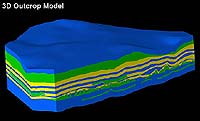
To better understand heterogeneity in petroleum reservoirs, it is useful to create three-dimensional stratigraphic models from outcrops, and then use the derived models as reservoir analogues to further model dynamic reservoirs. We used high-resolution, three-dimensional, digital-outcrop data from ramp carbonates of the Nama Group of Namibia to create static reservoir models.

The
Nama Group represents the shallow marine and fluvial, carbonate
and siliciclastic sedimentary fill of the Nama foreland basin,
which is located in southern Namibia. The basal unit of the
Nama Group, the terminal Proterozoic Kuibis Subgroup, represents
a northwest-dipping, storm- and wave-dominated carbonate ramp
that developed during

an overall increase in accommodation space.
The lowermost member of the Kuibis Subgroup, the Omkyk Member,
represents a shoaling-upward, layer-cake ramp sequence within
which microbial bioherms and biostromes developed at several
stratigraphic levels. These reefs and associated grainstones
are the units that were digitally mapped and modeled.

The Omkyk Member is well exposed in the Zebra River Canyon.
Grainstones typically form uniform thick beds with planar and
hummocky-cross stratification. Reefs geometries are variable
and comprise microbial columns (thrombolites and stromatolites)
with mudstone-to-grainstone intercolumn fills. Reefs and
grainstones are both interbedded with heterolithic units containing
various lithofacies, such as mudstones, microbial laminites, and
shales. A 3D stratigraphic model was constructed for the
updip part of the carbonate ramp. The model is 2
kilometers wide, 4 kilometers long, and 150 meters thick.
 To better understand heterogeneity in petroleum reservoirs, it is useful to create three-dimensional stratigraphic models from outcrops, and then use the derived models as reservoir analogues to further model dynamic reservoirs. We used high-resolution, three-dimensional, digital-outcrop data from ramp carbonates of the Nama Group of Namibia to create static reservoir models.
To better understand heterogeneity in petroleum reservoirs, it is useful to create three-dimensional stratigraphic models from outcrops, and then use the derived models as reservoir analogues to further model dynamic reservoirs. We used high-resolution, three-dimensional, digital-outcrop data from ramp carbonates of the Nama Group of Namibia to create static reservoir models.
 The
Nama Group represents the shallow marine and fluvial, carbonate
and siliciclastic sedimentary fill of the Nama foreland basin,
which is located in southern Namibia. The basal unit of the
Nama Group, the terminal Proterozoic Kuibis Subgroup, represents
a northwest-dipping, storm- and wave-dominated carbonate ramp
that developed during
The
Nama Group represents the shallow marine and fluvial, carbonate
and siliciclastic sedimentary fill of the Nama foreland basin,
which is located in southern Namibia. The basal unit of the
Nama Group, the terminal Proterozoic Kuibis Subgroup, represents
a northwest-dipping, storm- and wave-dominated carbonate ramp
that developed during  an overall increase in accommodation space.
The lowermost member of the Kuibis Subgroup, the Omkyk Member,
represents a shoaling-upward, layer-cake ramp sequence within
which microbial bioherms and biostromes developed at several
stratigraphic levels. These reefs and associated grainstones
are the units that were digitally mapped and modeled.
an overall increase in accommodation space.
The lowermost member of the Kuibis Subgroup, the Omkyk Member,
represents a shoaling-upward, layer-cake ramp sequence within
which microbial bioherms and biostromes developed at several
stratigraphic levels. These reefs and associated grainstones
are the units that were digitally mapped and modeled.  The Omkyk Member is well exposed in the Zebra River Canyon.
Grainstones typically form uniform thick beds with planar and
hummocky-cross stratification. Reefs geometries are variable
and comprise microbial columns (thrombolites and stromatolites)
with mudstone-to-grainstone intercolumn fills. Reefs and
grainstones are both interbedded with heterolithic units containing
various lithofacies, such as mudstones, microbial laminites, and
shales. A 3D stratigraphic model was constructed for the
updip part of the carbonate ramp. The model is 2
kilometers wide, 4 kilometers long, and 150 meters thick.
The Omkyk Member is well exposed in the Zebra River Canyon.
Grainstones typically form uniform thick beds with planar and
hummocky-cross stratification. Reefs geometries are variable
and comprise microbial columns (thrombolites and stromatolites)
with mudstone-to-grainstone intercolumn fills. Reefs and
grainstones are both interbedded with heterolithic units containing
various lithofacies, such as mudstones, microbial laminites, and
shales. A 3D stratigraphic model was constructed for the
updip part of the carbonate ramp. The model is 2
kilometers wide, 4 kilometers long, and 150 meters thick. 
